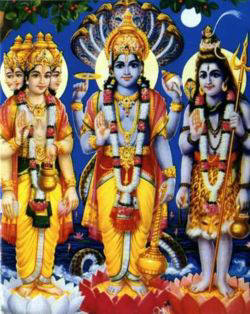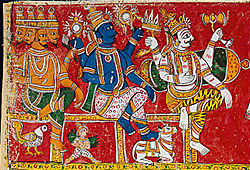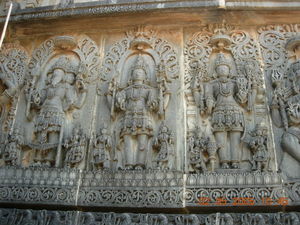Trimurti
2008/9 Schools Wikipedia Selection. Related subjects: Divinities
The Trimurti (English: ‘three forms’; Sanskrit: trimūrti) is a concept in Hinduism "in which the cosmic functions of creation, maintenance, and destruction are personified by the forms of Brahmā the creator, Viṣṇu the maintainer or preserver, and Śiva the destroyer or transformer." These three deities have been called "the Hindu triad" or the "Great Trinity". They are often looked at as the creator, preserver and destroyer respectively. Freda Matchett characterizes the Trimurti system as one of "several frameworks into which various divine figures can be fitted at different levels."
One type of depiction for the Trimurti shows three heads on one neck, and often even three faces on one head, each looking in a different direction.
The Trimurti (literally indicating three forms or trinity), is the representation of the three projections of the Supreme Reality, each with a specific cosmic function. These manifestations are that of Brahma (serving the cosmic function of creation), Vishnu (serving the cosmic function of renewal and preservation), and Shiva (serving the cosmic function of dissolution or destruction that precedes re-creation) – the three popular Hindu gods. Our daily existence reflects these three cosmic functions as birth, life and death. A somewhat similar symbolization exists in the Christian trinity of God as the Father, Son and Holy Ghost. However the interpretation and philosophy behind the Christian and Hindu concepts of the trinity differ.
The trinity is interpreted in various forms in Hindu philosophy. A widely accepted belief is that it represents earth, water, and fire. The earth, or Brahma, is seen as the originator of all life and hence is regarded as the Creator. Water is the sustainer of life and hence is the Preserver and is represented as Vishnu. Fire destructs life and hence is the Destroyer and is represented as Shiva.
Evolution of the concept
The Puranic period (c. CE 300-1200) saw the rise of post-Vedic religion and the evolution of what R. C. Majumdar calls "synthetic Hinduism." This period had no homogeneity, and included orthodox Brahmanism in the form of remnants of older Vedic cults, along with different sectarian religions, notably Shaivism, Vaishnavism, and Shaktism that were within the orthodox fold yet still formed distinct entities. One of the important traits of this period is a spirit of harmony between orthodox and sectarian forms. Regarding this spirit of reconciliation, R. C. Majumdar says that:
Its most notable expression is to be found in the theological conception of the Trimūrti, i.e., the manifestation of the supreme God in three forms of Brahmā, Viṣṇu, and Śiva.... But the attempt cannot be regarded as a great success, for Brahmā never gained an ascendancy comparable to that of Śiva or Viṣṇu, and the different sects often conceived the Trimūrti as really the three manifestations of their own sectarian god, whom they regarded as Brahman or Absolute.
Maurice Winternitz notes that there are very few places in Indian literature where the Trimurti is mentioned. The identification of Vishnu, Shiva, and Brahma as one being is strongly emphasized in the Kūrma Purana, where in 1.6 Brahman is worshipped as Trimurti; 1.9 especially inculcates the unity of the three gods, and 1.26 relates to the same theme.
Historian A. L. Basham explains the background of the trimurti as follows, noting Western interest in the idea of trinity:
Early western students of Hinduism were impressed by the parallel between the Hindu trinity and that of Christianity. In fact the parallel is not very close, and the Hindu trinity, unlike the Holy Trinity of Christianity, never really "caught on". All Hindu trinitarianism tended to favour one god of the three; thus, from the context it is clear that Kālidāsa's hymn to the Trimūrti is really addressed to Brahmā, here looked on as the high god. The Trimūrti was in fact an artificial growth, and had little real influence.
Views within Hinduism
Vaishnavism
Vaishnavism generally does not accept the Trimurti concept. For example, the Dvaita school holds Vishnu alone to be the supreme God, with Shiva subordinate, and interprets the Puranas differently. For example, Vijayindra Tîrtha, a Dvaita scholar interprets the 18 puranas differently. He interprets that the Vaishnavite puranas as satvic and Shaivite puranas as tamasic and that only satvic puranas are considered to be authoritative.
In Gaudiya Vaishnavism, Shiva is considered the best of devotee of Vishnu (vaisnavanam yatha sambhu) and also an aspect of Vishnu but not the same as Vishnu. In this view, Shiva is also viewed as subservient to Lord Vishnu, although it is still understood that he is above the category of an ordinary jiva (living entity). In one interpretation, Brahma is considered by Gaudiya Vaishnavites to be the highest of the jivas.
An analogy of the differences between milk and yogurt can be used to describe the differences in Brahma Samhita. Prabhupada commented that Shiva is not like a living entity, but is not Vishnu, with his position somewhere between Vishnu and Brahma. The analogy continues to hold Shiva to be like unto yogurt and Vishnu like unto milk: milk transforms into yogurt, but no one would consider yogurt to be milk.
However, other Vaishnavite followers, such as Swaminarayan, founder of the Hindu Swaminarayan sects (including BAPS), differ and hold that Vishnu and Shiva are different aspects of the same God. ; see also, verses 47, and 84 of Shikshapatri ; Notably, the Swaminarayan view is a minority view among Vaishnavites.
Saivism
Saivites, similarly hold a similar view with Shiva. Shiva performs four acts of creation, sustenance, reduction and blessing. Of these the latter three are nothing but the forms of the Supreme Shiva called Parasiva. Saivites thus believe that Lord Shiva is the Supreme, who assumes various critical roles and assumes appropriate names and forms, and also stands transcending all these.
Smartism
Smartism is a denomination of Hinduism that places emphasis on a group of five deities rather than just a single deity. The "worship of the five forms" (pañcāyatana pūjā) system, which was popularized by the ninth-century philosopher Śaṅkarācārya among orthodox Brahmins of the Smārta tradition, invokes the five deities Ganesha, Vishnu, Shiva, Devī, and Sūrya. This system was instituted by Śaṅkarācārya primarily to unite the principal deities of the five major sects on an equal status. The monistic philosophy preached by Śaṅkarācārya made it possible to choose one of these as a preferred principal deity and at the same time worship the other four deities as different forms of the same all-pervading Brahman.



